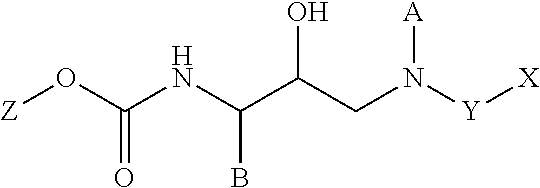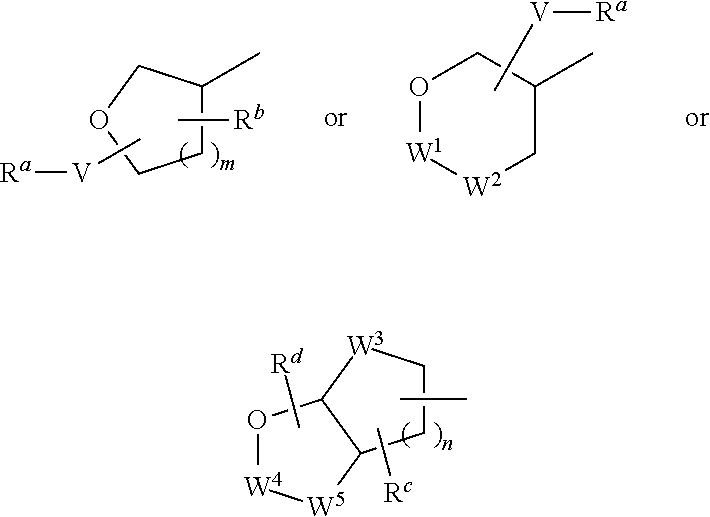HIV protease inhibitors and methods for using
- Summary
- Abstract
- Description
- Claims
- Application Information
AI Technical Summary
Benefits of technology
Problems solved by technology
Method used
Image
Examples
example 1
[0176](S)-2-(tert-Butyldiphenylsilyloxy)pentanedioic acid dimethyl ester (5). A mixture of (2S)-hydroxypentadienoic acid dimethyl ester 4 (Winitz, M.; et al., 1956) (0.39 g, 2.2 mmol), imidazole (0.45 g, 6.6 mmol) and tert-butyldiphenylsilyl chloride (1.2 mL, 4.4 mmol) in dry DMF (4 mL) was stirred at 23° C. for 4 h. Subsequently, the reaction mixture was poured into water and the aqueous phase was extracted with Et2O, the organic extracts were washed with 1 N HCl and brine, dried (Na2SO4) and the solvent was removed. The residue was purified by flash-chromatography (1:10 EtOAc / Hex) to furnish 0.89 g (90%) of 5 as a colourless oil: [α]D20=−21.1 (c 9.0, CHCl3); 1H NMR (CDCl3) δ 7.69-7.62 (m, 4H), 7.46-7.33 (m, 6H), 4.31 (t, J=5.4 Hz, 1H), 3.64 (s, 3H), 3.45 (s, 3H), 2.57-2.34 (m, 2H), 2.14-2.04 (m, 2H), 1.11 (s, 9H); 13C NMR (CDCl3) δ 173.4, 172.9, 135.9, 135.7, 133.0, 132.9, 129.9, 129.8, 127.7, 127.5, 71.4, 51.6, 51.5, 29.9, 28.9, 26.9, 19.4.
example 2
[0177](S)-2-(tert-Butyldiphenylsilyloxy)pentan-1,5-diol (6a). Compound 5 (0.8 g, 1.8 mmol) was dissolved in dry Et2O (8.5 mL) and the solution was cooled to 0° C., afterward lithium borohydride (0.12 g, 5.4 mmol) and dry methanol (0.22 mL, 5.4 mmol) were sequentially added. The resulting suspension was stirred at 23° C. for 24 h, then a few drops of 6 N HCl were added and the salts were filtered off. The filtrate was concentrated under reduced pressure and the residue was purified by flash-chromatography (1:1 EtOAc / Hex) to furnish 0.61 g (93%) of 6a as a colourless oil: [α]D20=−15.6 (c 3.1, CHCl3); 1H NMR (CDCl3) δ 7.70-7.65 (m, 4H), 7.44-7.32 (m, 6H), 3.82-3.77 (m, 1H), 3.53-3.48 (m, 2H), 3.45-3.41 (m, 2H), 1.65-1.47 (m, 4H), 1.05 (s, 9H); 13C NMR (CDCl3) δ 135.9, 135.7, 133.8, 133.7, 130.1, 129.8, 127.7, 127.6, 73.6, 65.7, 62.7, 29.7, 28.0, 27.0, 19.3.
example 3
[0178](S)-1-(tert-Butyldiphenylsilyloxy)-3,5-dioxacyclooctane (7a). To a mixture of 6a (0.55 g, 1.5 mmol) and paraformaldehyde (46 mg, 1.5 mmol) in EtOAc (30 mL), boron trifluoride etherate (195 μL, 1.5 mmol) was added and the resulting mixture was stirred at 23° C. for 4 h. The organic phase was washed with a saturated solution of NaHCO3, dried (Na2SO4) and the solvent was removed. The residue was purified by flash-chromatography (1:4 EtOAc / Hex) to afford 0.29 g (51%) of 7a as a colourless oil: [α]D20=−8.7 (c 1.9, CHCl3); 1H NMR (CDCl3) δ 7.67-7.63 (m, 4H), 7.45-7.34 (m, 6H), 4.69 (d, J=6.2 Hz, 1H), 4.45 (d, J=6.2 Hz, 1H), 4.03-3.95 (m, 1H), 3.70-3.61 (m, 1H), 3.59-3.48 (m, 3H), 1.93-1.80 (m, 1H), 1.77-1.61 (m, 2H), 1.47-1.34 (m, 1H), 1.12 (s, 9H); 13C NMR (CDCl3) δ 135.7, 134.2, 129.5, 127.5, 95.6, 72.2, 71.9, 69.0, 33.2, 27.0, 26.7, 19.2.
PUM
| Property | Measurement | Unit |
|---|---|---|
| Molar density | aaaaa | aaaaa |
| Molar density | aaaaa | aaaaa |
| Molar density | aaaaa | aaaaa |
Abstract
Description
Claims
Application Information
 Login to View More
Login to View More - R&D
- Intellectual Property
- Life Sciences
- Materials
- Tech Scout
- Unparalleled Data Quality
- Higher Quality Content
- 60% Fewer Hallucinations
Browse by: Latest US Patents, China's latest patents, Technical Efficacy Thesaurus, Application Domain, Technology Topic, Popular Technical Reports.
© 2025 PatSnap. All rights reserved.Legal|Privacy policy|Modern Slavery Act Transparency Statement|Sitemap|About US| Contact US: help@patsnap.com



